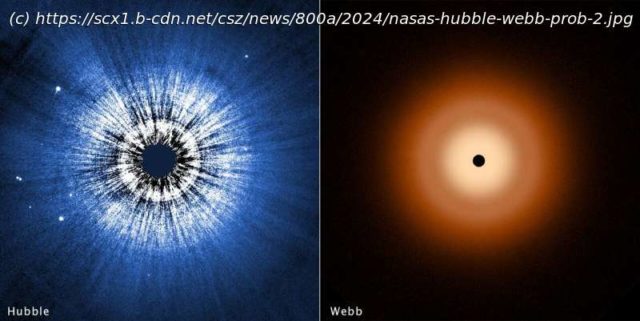In the 1997 movie «Contact,» adapted from Carl Sagan’s 1985 novel, the lead character scientist Ellie Arroway (played by actor Jodi Foster) takes a space-alien-built wormhole ride to the star Vega. She emerges inside a snowstorm of debris encircling the star—but no obvious planets are visible.
In the 1997 movie «Contact», adapted from Carl Sagan’s 1985 novel, the lead character scientist Ellie Arroway (played by actor Jodi Foster) takes a space-alien-built wormhole ride to the star Vega. She emerges inside a snowstorm of debris encircling the star—but no obvious planets are visible.
It looks like the filmmakers got it right.
A team of astronomers at the University of Arizona, Tucson used NASA’s Hubble and James Webb space telescopes for an unprecedented in-depth look at the nearly 100-billion-mile-diameter debris disk encircling Vega.
«Between the Hubble and Webb telescopes, you get this very clear view of Vega. It’s a mysterious system because it’s unlike other circumstellar disks we’ve looked at», said Andras Gáspár of the University of Arizona, a member of the research team. «The Vega disk is smooth, ridiculously smooth.»
The big surprise to the research team is that there is no obvious evidence for one or more large planets plowing through the face-on disk like snow tractors. «It’s making us rethink the range and variety among exoplanet systems», said Kate Su of the University of Arizona, lead author of the paper presenting the Webb findings.
Webb sees the infrared glow from a disk of particles the size of sand swirling around the sizzling blue-white star that is 40 times brighter than our sun. Hubble captures an outer halo of this disk, with particles no bigger than the consistency of smoke that are reflecting starlight.
The distribution of dust in the Vega debris disk is layered because the pressure of starlight pushes out the smaller grains faster than larger grains. «Different types of physics will locate different-sized particles at different locations», said Schuyler Wolff of the University of Arizona team, lead author of the paper presenting the Hubble findings. «The fact that we’re seeing dust particle sizes sorted out can help us understand the underlying dynamics in circumstellar disks.»
The Vega disk does have a subtle gap, around 60 AU (astronomical units) from the star (twice the distance of Neptune from the sun), but otherwise is very smooth all the way in until it is lost in the glare of the star.






